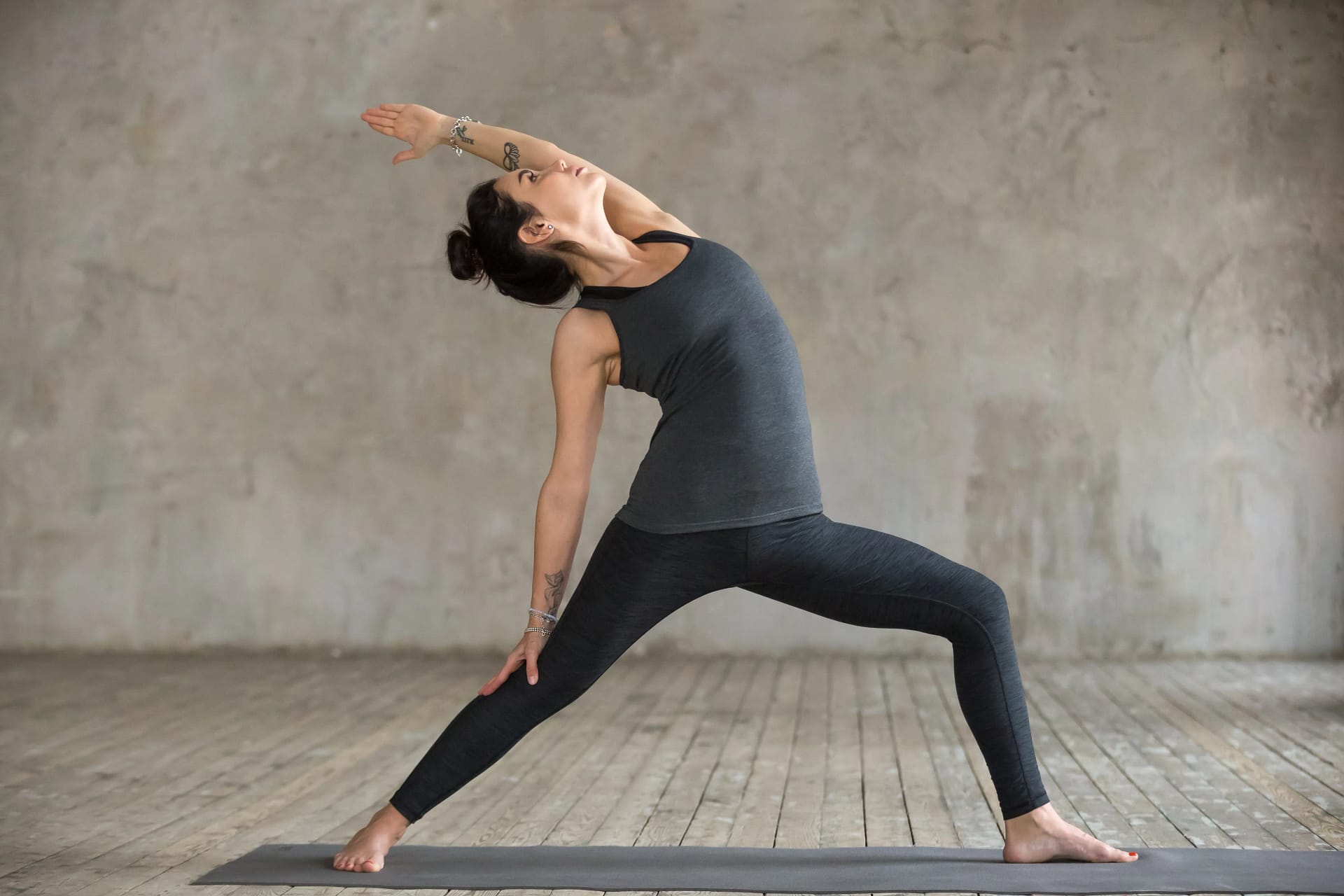Amazing yoga pose Reverse Warrior (Viparita Virabhadrasana) stimulates your practice with a refreshing and transforming energy, allowing you to explore new depths. You can explore the complexities of this asana, including its right form, variations, and key insights into avoiding frequent errors, in the parts that follow. You can fully master this powerful side bend here. Reverse Warrior offers an assortment of advantages that will lift your mental and physical health to new maximums, whether you are a seasoned yogi, advanced in the practice of yoga, or someone just beginning on an amazing path of self-discovery.
Learn the specifics of its shape so that it can have a significant impact on your practice. Explore variations that provide a wide range of options that fit your own demands and interests. You can also learn from typical mistakes with the tools to make the most of every movement. This in-depth explanation of this powerful yoga pose will create a deep mind-body connection.
Reverse Warrior has the potential to show you a wide range of benefits that will significantly impact your entire health, regardless of your level of expertise, whether you are a committed practitioner or a curious person taking your first steps onto the mat. As you go into the depths of this interesting yoga sequence, prepare to go on a journey of self-discovery. Through the practice of Reverse Warrior, you may strengthen your physical body, broaden your mental perspectives, and lift your spirit.
With Reverse Warrior, you may discover your actual potential.
Also Known As: Proud Warrior, Peaceful Warrior, Crescent Pose
Targets: Hamstrings, quadriceps, intercostal muscles
Level: Beginner
Understanding Reverse Warrior
Reverse Warrior is a captivating pose that combines a side bend with a lunge position, making it a standout among the more commonly practiced forward bends and backbends. This particular pose targets the intercostal muscles located between your ribs, an area often overlooked but deserving of attention. By incorporating a side stretch and reaching your right arm upward first and backward second, you maximize the stretch along the corresponding side of your body. Unlike a traditional backbend, which emphasizes equal extension on both sides, Reverse Warrior allows you to focus on lengthening the side body while maintaining stability.
Benefits of practicing Reverse Warrior pose
Reverse Warrior offers a wide range of benefits that contribute to your overall well-being. By incorporating this pose into your practice, you strengthen your legs, open up your side body, improve spinal mobility, and enhance your balance and core strength. The stretch provided by Reverse Warrior engages the front and rear thigh muscles (quadriceps and hamstrings), hips, groin muscles, and the intercostal muscles between the ribs. Additionally, this asana serves as an effective hip opener, which is particularly beneficial for individuals who spend prolonged periods sitting. Moreover, Reverse Warrior stimulates energy flow, promoting better breathing and circulation throughout the body.
How to do Reverse Warrior in a lunge position?

Image by yanalya on Freepik
To perform Reverse Warrior correctly and reap its full benefits, follow these step-by-step instructions:
- Begin in Warrior II pose, with your right foot positioned forward.
- Lean your torso toward the front of your mat and simultaneously raise your right hand toward the ceiling. This movement creates a significant stretch along the right side of your body. Keep your right arm plugged into the shoulder socket for stability.
- Allow your left hand to rest lightly on the back of your left thigh, while your gaze remains fixed on your right fingertips.
- Hold the pose for five deep breaths.
- Repeat the steps, this time with your left foot forward, to achieve balance and ensure a comprehensive practice.
Common Mistakes to Avoid
To fully maximize the benefits of Reverse Warrior and prevent strain or injury, be mindful of the following common mistakes:
- Knee positioned too far forward or drifting inward: In any lunge position, it’s essential to avoid extending your forward knee beyond your toes or allowing it to drift toward the inside. Both actions can place unnecessary stress on the knee joint. Focus on maintaining proper alignment throughout the pose.
- Insufficient flexion in the front knee: As you lean your upper body backward, be mindful of your front knee. It’s common for the knee to straighten inadvertently. Ensure that your knee remains bent directly over your ankle. If necessary, consciously deepen the bend in your front knee.
- Reliance on the back hand for support: The support for Reverse Warrior should primarily come from your core strength, not from resting your hand on your leg. Avoid placing any weight on your back hand and instead engage your core muscles for stability.
Modifications and Variations
To accommodate different skill levels and individual needs, here are some modifications and variations to consider:
- Modification for balance difficulties: If you find it challenging to maintain balance, try shifting your gaze downward, focusing on your left foot instead of looking up at your right fingertips. Additionally, widening your feet slightly can provide added stability.
- Advanced variation for increased challenge: For those seeking a greater challenge, try wrapping your left arm behind your back and reaching for the inner right thigh. This modification allows you to deepen the stretch and open your chest further toward the ceiling.
Safety and Precautions
While Reverse Warrior offers numerous benefits, it’s essential to exercise caution and be mindful of any limitations or pre-existing conditions. Avoid this pose if you have difficulties with balance or if you’re dealing with hip, knee, back, or shoulder injuries.Maintain a neutral position with your eyes ahead rather than leaning your head back if you have a neck pain. Remember that you should feel a stretch in your thighs, groin, and sides, but you should never experience any sharp pain. If discomfort or pain arises, release the pose immediately.
Incorporating Reverse Warrior
To maximize the benefits of Reverse Warrior and integrate it into your practice seamlessly, consider incorporating it into the following workouts and sequences:
– Warrior sequence: Combine Reverse Warrior with other warrior poses to create a dynamic and invigorating sequence that strengthens your body and enhances flexibility.
– Standing yoga sequence: Incorporate Reverse Warrior into a comprehensive standing yoga sequence to build strength, improve balance, and promote mindful movement.
– Yoga poses for beginners: Use Reverse Warrior as a foundational pose in a beginner-friendly sequence to introduce newcomers to the world of yoga and its many benefits.
If you implement this strong yoga pose into your yoga practice, you can gain a new level of strength, flexibility, and inner peace.
Remember, consistency and proper form are key to reaping the full benefits of Reverse Warrior. Enjoy your journey as you explore the transformative power of this remarkable pose!
*Note: The information provided in this article is for informational and educational purposes only. It is not a substitute for professional medical advice, diagnosis, or treatment.*
FAQ Page about Reverse Warrior
What is Reverse Warrior?
Reverse Warrior is a yoga pose that combines a side bend with a lunge position, creating a unique stretch along the side of the body.
What muscles does Reverse Warrior engage?
Reverse Warrior engages a variety of muscles, including the intercostal muscles between the ribs, the quadriceps and hamstrings in the legs, and the core muscles for stability and balance.
What are the benefits of practicing Reverse Warrior?
Practicing Reverse Warrior offers several benefits, such as strengthening the side body, improving flexibility and balance, stretching the leg muscles, and promoting a sense of grounding and mindfulness.
Can Reverse Warrior be practiced by beginners?
Yes, beginners can practice Reverse Warrior with proper guidance and modifications. It’s important to start slowly, listen to your body, and work within your comfort zone to avoid strain or injury.
How often should Reverse Warrior be practiced?
The frequency of practicing Reverse Warrior can vary based on individual preferences and goals. It can be practiced regularly as part of a yoga routine or incorporated into specific sequences or classes. Consistency is key to experiencing the benefits of the pose over time.




